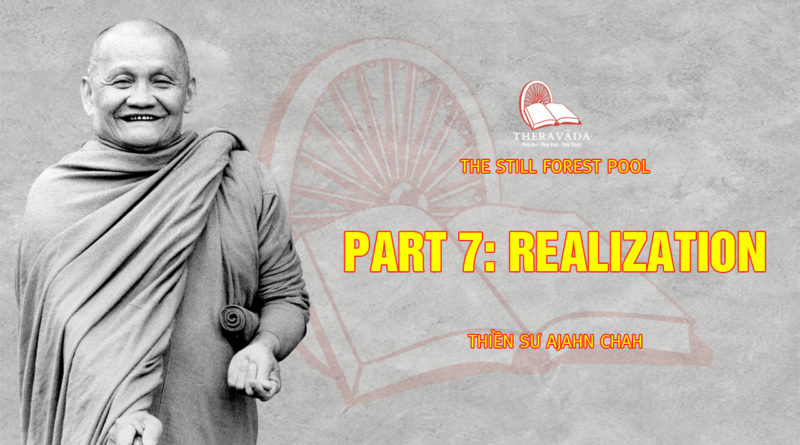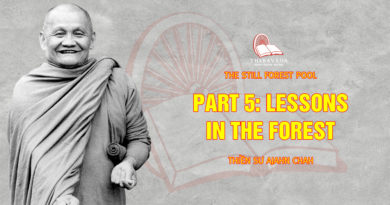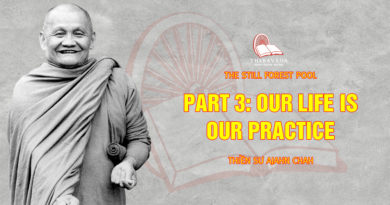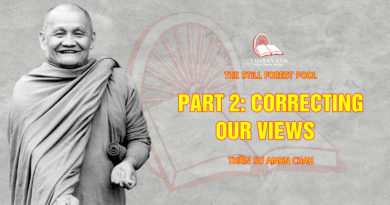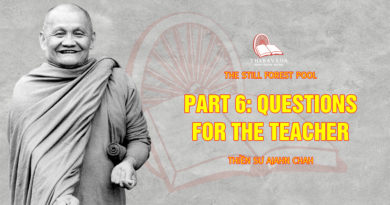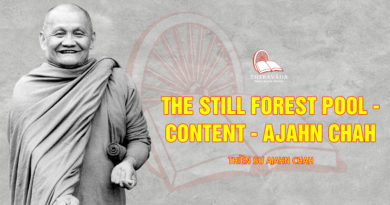PART 7
Realization
It is a wonderful discovery to see that the enlightenment and joy described in the ancient Buddhist texts still exist today. We see it in Achaan Chah who stresses its timeless nature and speaks to us as a living example. He urges us to understand and realize freedom in our own hearts through right practice and true understanding.
And, indeed, this is possible. People today, as through the centuries, are discovering enlightenment through the path of insight and mindfulness, not only Achaan Chah but his students as well, and those of many other Buddhist teachers. It is here to discover. Its essence is no farther than our own bodies and mind. Achaan Chah puts it very directly: Lay it all down, all grasping and judging, don’t try to be anything. Then in the stillness you can let yourself see through the whole illusion of self. We don’t own any of it. When we are inwardly silent and awake, we will come to this realization spontaneously and freely. No permanent self. No one inside. Nothing. Just the play of the senses.
This realization brings freedom, vitality, joy. The sense of life’s burdens drops, together with the sense of self. What is left is reflected in these pages, clarity and openness of heart, a wise and free spirit.
As Achaan Chah says, why not give it a try?
Not-Self
When one does not understand death, life can be very confusing. If our body really belonged to us, it would obey our commands. If we say, “Don’t get old,” or “I forbid you to get sick,” does it obey us? No, it takes no notice. We only rent this house, not own it. If we think it belongs to us, we will suffer when we have to leave it. But in reality, there is no such thing as a permanent self, nothing solid or unchanging that we can hold on to.
Buddha made a distinction between ultimate truth and conventional truth. The idea of a self is merely a concept, a convention-American, Thai, teacher, student, all are conventions. Ultimately no one exists, only earth, fire, water, and air-elements that have combined temporarily. We call the body a person, my self, but ultimately there is no me, there is only anatta, not-self. To understand not-self, you have to meditate. If you only intellectualize, your head will explode. Once you understand not-self in your heart, the burden of life will be lifted. Your family life, your work, everything will be much easier. When you see beyond self, you no longer cling to happiness, and when you no longer cling to happiness, you can begin to be truly happy.
Short and Straight
A devout, elderly village lady from a nearby province came on a pilgrimage to Wat Ba Pong. She told Achaan Chah she could stay only a short time, as she had to return to take care of her great grandchildren, and since she was an old lady, she asked if he could please give her a brief Dharma talk.
He replied with great force, “Hey, listen. There’s no one here, just this. No owner, no one to be old, to be young, to be good or bad, weak or strong. Just this, that’s all; various elements of nature playing themselves out, all empty. No one born and no one to die. Those who speak of death are speaking the language of ignorant children. In the language of the heart, of Dharma, there’s no such thing.
‘When we carry a burden, it’s heavy. When there’s no one to carry it, there’s not a problem in the world. Do not look for good or bad or for anything at all. Do not be anything. There’s nothing more; just this.”
Underground Water
The Dharma belongs to no one; it has no owner. It arises in the world when a world manifests, yet stands alone as the truth. It is always here, unmoving, limitless, for all who seek it. It is like water underground- whoever digs a well finds it. Yet whether or not you dig, it is always here, underlying all things.
In our search for the Dharma, we search too far, we overreach, overlooking the essence. The Dharma is not out there, to be gained by a long voyage viewed through a telescope. It is right here, nearest to us, our true essence, our true self, no self. When we see this essence, there are no problems, no troubles. Good, bad, pleasure, pain, light, dark, self, other, are empty phenomena. If we come to know this essence, we die to our old sense of self and become truly free.
We practice to give up, not to attain. But before we can give up mind and body, we must know their true nature. Then detachment naturally arises.
Nothing is me or mine, all is impermanent. But why can’t \re say nirvana is mine? Because those who realize nirvana do not have thoughts of me or mine. If they did, they could not realize nirvana. Although they know the sweetness of honey, they do not think, “I am tasting the sweetness of honey.”
The Dharma Path is to keep walking forward. But the true Dharma has no going forward, no going backward, and no standing still.
The Joy of the Buddha
If all is impermanent, unsatisfactory, and selfless, then what is the point of existence? One man watches a river flow by. If he does not wish it to flow, to change ceaselessly in accord with its nature, he will suffer great pain. Another man understands that the nature of the river is to change constantly, regardless of his likes and dislikes, and therefore he does not suffer. To know existence as this flow, empty of lasting pleasure, void of self, is to find that which is stable and free of suffering, to find true peace in the world.
‘Then,” some people may ask, “what is the meaning of life? Why are we born?” I cannot tell you. Why do you eat? You eat so that you do not have to eat anymore. You are born so that you will not have to be born again.
To speak about the true nature of things, their voidness or emptiness, is difficult. Having heard the teachings, one must develop the means to understand. Why do we practice? If there is no why, then we are at peace. Sorrow cannot follow the one who practices like this.
The five aggregates are murderers. Being attached to body, we will be attached to mind, and vice versa. We must cease to believe our minds. Use the precepts and calming of the heart to develop restraint and constant mindfulness. Then you will see happiness and displeasure arising and not follow either, realizing that all states are impermanent, unsatisfactory, and empty. Learn to be still. In this stillness will come the true joy of the Buddha.
Picking Up Mangoes
When you have wisdom, contact with sense objects, whether good or bad, pleasant or painful, is like standing at the bottom of a mango tree and collecting the fruit while another person climbs up and shakes it down for us. We get to choose between the good and rotten mangoes, and we do not waste our strength because we do not have to climb up the tree.
What does this mean? All the sense objects that come to us are bringing us knowledge. We do not need to embellish them. The eight worldly winds gain and loss, fame and disrepute, praise and blame, pain and pleasure-come of their own. If your heart has developed tranquility and wisdom, you can enjoy picking and choosing. What others may call good or bad, here or there, happiness or suffering, is all to your profit, because someone else has climbed up to shake the mangoes down, and you have nothing to fear.
The eight worldly winds are like mangoes falling down to you. Use your concentration and tranquility to contemplate, to collect. Knowing which fruits are good and which are rotten is called wisdom, vipassana. You do not make it up or create it. If there is wisdom, insight arises naturally. Although I call it wisdom, you do not have to give it a name.
The Timeless Buddha
The original heart / mind shines like pure, clear water with the sweetest taste. But if the heart is pure, is our practice over? No, we must not cling even to this purity. We must go beyond all duality, all concepts, all bad, all good, all pure, all impure. We must go beyond self and no self, beyond birth and death. To see a self to be reborn is the real trouble of the world. True purity is limitless, untouchable, beyond all opposites and all creation.
We take refuge in Buddha, Dharma, and Sangha. This is the heritage of every Buddha that appears in the world. What is this Buddha? When we see with the eye of wisdom, we know that the Buddha is timeless, unborn, unrelated to any body, any history, any image. Buddha is the ground of all being, the realization of the truth of the unmoving mind.
So the Buddha was not enlightened in India. In fact he was never enlightened, was never born, and never died. This timeless Buddha is our true home, our abiding place. When we take refuge in the Buddha, Dharma, and Sangha, all things in the world are free for us. They become our teacher, proclaiming the one true nature of life.
Yes, I Speak Zen
A visiting Zen student asked Achaan Chah, “How old are you? Do you live here all year round?”
“I live nowhere,” he replied. “There is no place you can find me. I have no age. To have age, you must exist, and to think you exist is already a problem. Don’t make problems; then the world has none either. Don’t make a self. There’s nothing more to say.”
Perhaps the Zen student glimpsed that the heart of vipassana is no different from the heart of Zen.
The Unstruck Gong
Living in the world and practicing meditation, you will seem to others like a gong that has not been struck and is not producing any sound. They will consider you useless, mad, defeated; but actually, just the opposite is true.
Truth is hidden in untruth, permanence is hidden in impermanence.
Nothing Special
People have asked about my own practice. How do I prepare my mind for meditation? There is nothing special. I just keep it where it always is. They ask, “Then are you an arhat (one who has reached a high stage of spiritual progress)?” Do I know? I am like a tree, full of leaves, blossoms, and fruit. Birds come to eat and to nest. Yet the tree does not know itself. It follows its nature; it is as it is.
Inside You is Nothing, Nothing at All
In my third year as a monk, I had doubts about the nature of samadhi and wisdom. Really desiring to experience samadhi, I strove ceaselessly in my practice. As I sat in meditation, I would try to figure out the process, and therefore my mind was especially distracted. When I did nothing in particular and was not meditating, I was fine. But when I determined to concentrate my mind, it would become extremely agitated.
“What’s going on?” I wondered. “Why should it be like this?” After a while, I realized that concentration is like breathing. If you determine to force your breaths to be deep or shallow, fast or slow, breathing becomes difficult. But when you are just walking along, not aware of your inhalation and exhalation, breathing is natural and smooth. In the same way, any attempt to force yourself to become tranquil is just an expression of attachment and desire and will prevent your attention from settling down.
As time went by, I continued to practice with great faith and growing understanding. Gradually I began to see the natural process of meditation. Since my desires were clearly an obstacle, I practiced more openly, investigating the elements of mind as they occurred. I sat and watched, sat and watched, over and over again.
One day, much later in my practice, I was walking in meditation sometime after 11pm. My thoughts were almost absent. I was staying at a forest monastery and could hear a festival going on in the village in the distance. After I became tired from walking meditation, I went to my hut. As I sat down, I felt that I could not get into the cross-legged posture fast enough. My mind naturally wanted to enter into deep concentration. It just happened on its own. I thought to myself, “Why is it like this?” When I sat, I was truly tranquil; my mind was firm and concentrated. Not that I did not hear the sound of singing coming from the village, but I could make myself not hear it as well.
With the mind one-pointed, when I turned it toward sounds, I heard; when I did not, it was quiet. If sounds came, I would look at the one who was aware, who was separate from sounds, and contemplate, “If this isn’t it, what else could it be?” I could see my mind and its object standing apart, like this bowl and kettle here. The mind and the sounds were not connected at all. I kept examining in this way, and then I understood. I saw what held subject and object together, and when the connection was broken, true peace emerged.
On that occasion, my mind was not interested in anything else. If I were to have stopped practicing, I could have done so at my ease. When a monk stops practicing, he is supposed to consider: “Am I lazy? Am I tired? Am I restless?” No, there was no laziness or tiredness or restlessness in my mind, only completeness and sufficiency in every way.
When I stopped for a rest, it was only the sitting that stopped. My mind remained the same, unmoved. As I lay down, at that moment my mind was tranquil as before. As my head hit the pillow, there was a turning inward in the mind. I did not know where it was turning, but it turned within, like an electric current being switched on, and my body exploded with loud noises. The awareness was as refined as seemed possible. Passing that point, the mind went in further. Inside was nothing, nothing at all; nothing went in there, nothing could reach. The awareness stopped inside for awhile and then came out. Not that I made it come out-no, I was merely an observer, the one who was aware.
When I came out of this condition, I returned to my normal state of mind, and the question arose, “What was that?” The answer came, ‘These things are just what they are; there’s no need to doubt them:’ Just this much said, and my mind could accept.
After it had stopped for awhile, the mind turned inward again. I did not turn it, it turned itself. When it had gone in, it reached its limit as before. This second time, my body broke into fine pieces, and the mind went further in, silent, unreachable. When it had gone in and stayed for as long as it wished, it came out again, and I returned to normal. During this time, the mind was self-acting. I did not try to make it come and go in any particular way. I only made myself aware and observed. I did not doubt. I just continued to sit and contemplate.
The third time the mind went in, the whole world broke apart: the earth, grass, trees, mountains, people, all was just space. Nothing was left. When the mind had gone in and abided as it wished, had stayed for as long as it could, the mind withdrew, and returned to normal. I do not know how it abided; such things are difficult to see and to speak about. There is nothing to compare it with.
Of these three instances, who could say what had occurred? Who could know? What could I call it? What I have spoken about here is all a matter of the nature of mind. It is not necessary to speak of the categories of mental factors and consciousness. With strong faith I went about practice, ready to stake my life, and when I emerged from this experience the whole world had changed. All knowledge and understanding had been transformed. Someone seeing me might have thought I was mad. In fact, a person without strong mindfulness might well have gone mad, because nothing in the world was as before. But it was really just I who had changed, and yet still I was the same person. When everyone would be thinking one way, I would be thinking another; when they would speak one way, I would speak another. I was no longer running with the rest of humankind.
When my mind reached the peak of its power, it was basically a matter of mental energy, of the energy of concentration. On the occasion I just described, the experience was based on the energy of samadhi. When samadhi reaches this level, vipassana flows effortlessly.
If you practice like this, you do not have to search very far. Friend, why don’t you give it a try?
There is a boat you can take to the other shore. Why not jump in? Or do you prefer the ooze and the slime? I could paddle away any time, but I am waiting for you.
In Ending
In ending, I hope that you will continue your journeys and practice with much wisdom. Use the understanding that you have already developed to persevere in practice. This can become the ground for your growth, for the deepening of yet greater understanding and love. You can deepen your practice in many ways. If you are timid in practice, then work with your mind so that you can overcome that. With the proper effort and with time, understanding will unfold by itself. But in all cases, use your own natural wisdom. What we have spoken of is what I feel is helpful to you. If you really do it, you can come to the end of all doubt. You come to where you have no more questions, to that place of silence, to the place in which there is oneness with the Buddha, with the Dharma, with the universe. And only you can do that.
From now on it’s up to you.
____________________

